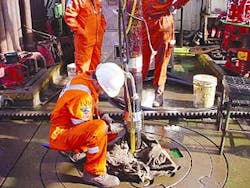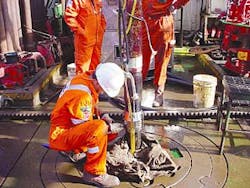Capping a 5-year joint effort with Baker Oil Tools, Petroleo Brasileiro SA (Petrobras) installed a deepwater all-electric completion in a Marlim Sul subsea well, in the Campos basin off Brazil.
A dynamically positioned (DP) drilling rig, working in 3,832 ft of water, ran the system which is tied-back to the Petrobras P-40 floating production vessel by a 3.7-mile umbilical. Petrobras can monitor the system from any point within its internal network.
Baker Oil Tools says that the intelligent system remotely monitors the injection of 15,000-20,000 b/d of water into the 8-MLS-67HA-RJS well to determine the water distribution into two discrete intervals.
The system monitors real-time measurements of downhole pressure, temperature, and flow in both the tubing and annulus; this enables the operator to manage injection in real time and to selectively control individual zonal flow rates. That allows continuous well optimization in response to changing downhole conditions.
null
Components
Baker Oil Tools describes the deployed system as including a cable by-pass expansion joint, retrievable feed-through packer, two flow measurement units, dry-mateable connectors, a single tubing encapsulated conductor (TEC) line for power and communication, supervisory surface control system, and two intelligent production regulators (IPRs).
Petrobras uses Baker Oil Tools' InCode software to monitor and control the system's downhole devices that include eight QuantX quartz pressure sensors for monitoring tubing and annulus pressure at the IPR valves and internal pressure at the flow measurement units.
QuantX Wellbore Instrumentation is a 50:50 joint venture of Expro International Group PLC and Baker Hughes Inc. that was established in 2003 to develop and market permanent monitoring technologies.
Project
The 5-year development project involved Baker Oil Tools, Baker Atlas, Petrobras, and QuantX.
Baker Oil Tool says that following a factory acceptance test in Houston, it deployed and commissioned the system in 2001 in the Varginha 8-VRG-8RN well onshore Brazil on May 22, 2001 (OGJ, Oct. 22, 2001, p. 52). Remote control and monitoring of the system was through a satellite link from a PC-based, surface-control system at Petrobras' operational base in Natal, 165 miles from the well site.
After 11 months of operation, Petrobras retrieved the system from the land well and in August 2003 installed it in the Marlim Sul well.
The field
The Marlim Sul field, discovered in November 1987, is about 75 miles off the northern shoreline of Brazil, in 2,800-7,900 ft water depths. The field covers about 150,000 acres.
Petrobras is developing the field in four production stages or modules, two of which are undergoing development, and two are still being evaluated. It says the field has 57 subsea producing wells and 42 injection wells and forecasts a peak production from the field of 470,000 boe/d in 2009. The field produced an average 152,000 bo/d in 2002.
The Petrobras-40 (P-40) floating semisubmersible production vessel, moored in about 3,550 ft of water, treats the production from the Module 1 area. After treatment, the produced oil goes to the P-38, floating, storage, and offloading (FSO) vessel, moored in 3,310 ft of water, while the produced gas is compressed on P-40 and transferred to the Namorado Platform (PNA-1) where it enters the Campos basin gas pipeline network.



